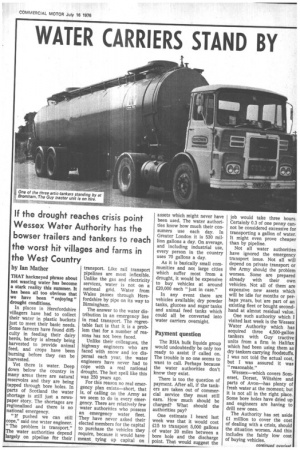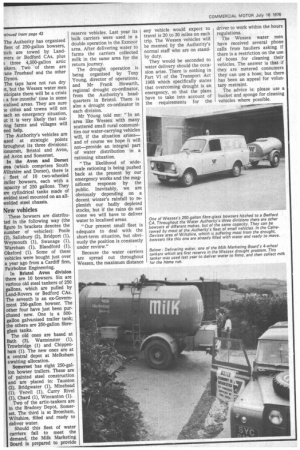If the drought reaches crisis point Wessex Water Authority has
Page 45

Page 46

If you've noticed an error in this article please click here to report it so we can fix it.
the bowser trailers and tankers to reach the worst hit villages and farms in the West Country
by Ian Mather
THAT hackneyed phrase about not wasting water has become a stark reality this summer. It has been all too obvious that we have been " enjoying " drought conditions.
In places in Herefordshire villagers have had to collect their water in plastic buckets just to meet their basic needs. Some farmers have found difficulty in feeding their dairy herds, barley is already being harvested to provide animal feed, and crops have been burning before they can be harvested.
Yet there is water. Deep down below the country in many areas there are natural reservoirs and they are being tapped through bore holes. In parts of Scotland the water shortage is still just a newspaper story. The shortages are regionalised and there is no national emergency.
"If pushed we can still cope," said one water engineer. "The problem is transport." The water authorities depend largely on pipeline fOr their transport. Like rail transport pipelines are most inflexible. Unlike the gas and electricity services, water is not on a national grid. Water from Wales passes through Herefordshire by pipe on its way to Birmingham.
The answer to the water distribution in an emergency lies in road transport. The regrettable fact is that it is a problem that for a number of reasons has not been faced.
Unlike their colleagues, the highway engineers who are faced with snow and ice dispersal each year, the water engineers have never had to cope with a real national drought. The last spell like this was 250 years ago.
For this reason no real emergency plan exists—short, that is, of calling on the Army as we seem to do in every emergency. There are relatively few water authorities who possess an emergency water fleet. They have never asked their elected members for the capital to purchase the vehicles they require, because it would have meant tying up capital on assets which might never have been used. The water authorities know how much their consumers use each day. In Greater London it is 530 million gallons a day. On average, and including industrial use, every person in the country uses 70 gallons a day.
As it is basically small communities and not large cities which suffer most from a drought, it would be expensive to buy vehicles at around -£20,000 each "just in case."
In any event there are vehicles available; dry powder tanks, glucose and sugar tanks and animal feed tanks which could all be converted into water carriers overnight.
Payment question
The RHA bulk liquids group would undoubtedly be only too ready to assist if called on. The trouble is no one seems to want to call. Perhaps because the water authorities don't know they exist.
There is too the question of payment. After all, if the tankers are taken out of commercial service they must still earn. How much should be charged? What should the authorities pay?
One estimate I heard last week was that it would cost £15 to transport 5,000 gallons . of water 20 miles between a bore hole and the discharge point. That would suggest the job would take three hours. Certainly 0.3 of one penny cannot be considered excessive for transporting a gallon of water. It might even prove cheaper than by pipeline.
Not all water authorities have ignored the emergency transport issue. Not all will depend on private transport or the Army should the problem worsen. Some are prepared already with their own vehicles. Not all of them are expensive new assets which will be idle for months or perhaps years, but are part of an existing fleet or bought secondhand at almost residual value.
One such authority which visited last week is the Wessex Water Authority which has acquired three 4,500-gallon tankers with Guy tractive units from a firm in Halifax which had been using them as dry tankers carrying foodstuffs. I was not told the actual cost, but I was assured it was "reasonable."
Wessex—which covers Somerset, Dorset, Wiltshire and parts of Avon—has plenty of fresh water at the moment; but it is not all in the right place. Some bore holes have dried up and engineers are having to drill new ones.
The Authority has set aside El million to cover the cost of dealing with a crisis, should the situation worsen. And this includes the fairly low cost of buying vehicles.
continued ovnrieRf The Authority has organised fleet of 250-gallon bowsers, lich are towed by Landwers or Bedford CAs, plus ; three 4,500-gallon artic nkers. Two of them are .ane Fruehauf and the other Dyson.
The taps have not run dry ?,.t, but the Wessex water men lticipate there will be a crisis a few months' time in some icalised areas. They are sure le cities and towns will not ?.ach an emergency situation, ut it is very likely that outring farms and villages will eed help.
The Authority's vehicles are ,ased at strategic points hroughout its three divisions: ■ omerset, Bristol and Avon, ,nd Avon and Somerset.
In the Avon and Dorset irea (which comprises South Wiltshire and Dorset), there is fleet of 10 two-wheeled Taller bowsers, each with a :apacity of 250 gallons. They ire cylindrical tanks made of welded steel mounted on an allwelded steel chassis.
New vehicles
These bowsers are distributed in the following way (the figure in brackets denotes the number of vehicles): Poole (2), Salisbury (2), Bridport (1), Weymouth (1), Swanage (1), Wareham (1), BIandford (1), Okeford (1). Some of these vehicles were bought just over a year ago from a Cardiff firm, Fa irholme Engineering.
In Bristol Avon division there are 10 bowsers. Six are various old steel tankers of 250 gallons, which are pulled by Land-Rovers or Bedford CAs. The seventh is an ex-Government 250-gallon bowser. The other four have just been purchased new. One is a 500gallon galvanised trailer tank; • the others are 250-gallon fibreglass tanks.
The old ones are based at Bath (3), Warminster (1), Trowbridge (I) and Chippenham (1). The new ones are at a central depot at Melksham awaiting allocation.
Somerset has eight 250-gallon bowser trailers. These are of painted steel construction and are placed in: Taunton (2), Bridgwater (1), Minehead (1), Yeovil (1), Curry Rivel (1), Chard (1), Wincanton (1).
Two of the artic-tankers are in the Bradney Depot, Somerset. The third is at Bromham, Wiltshire, filled and ready to deliver water.
Should this fleet of water carriers fail to meet the demand, the Milk Marketing Board is prepared to provide reserve vehicles. Last year its bulk carriers were used in a double operation in the Exmoor area. After delivering water to farms the carriers collected milk in the same area for the return journey.
The drought operation is being organised by Tony Young, director of operations, and Mr Frank Howarth, regional drought co-ordinator, from the Authority's headquarters in Bristol. There is also a drought co-ordinator in each division.
Mr Young told me: " In an area like Wessex with many scattered small rural communities our water-carrying vehicles will, if the situation arises— and of course we hope it will not—provide an integral part of water distribution in a rationing situation.
"The likelihood of widescale rationing is being pushed back at the present by our emergency works and the magnificent response by the public. Inevitably, we are obviously depending on a decent winter's rainfall to replenish our badly depleted stocks, but if the rains do not come we will have to deliver water to localised areas.
" Our present small fleet is adequate to deal with the short-term situation, but obviously the position is constantly under review."
Because the water carriers are spread out throughout Wessex, the maximum distance any vehicle would expect to travel is 20 to 30 miles on each trip. The Wessex vehicles will be manned by the Authority's normal staff who are on standby duty.
They would be seconded to water delivery should the occasion arise. There is nothing in Part VI of the Transport Act 1968 which specifically states that overcoming drought is an emergency, so that the plans have to take into account of the requirements for the driver to work within the hours regulations.
The Wessex water men have received several phone calls from hauliers asking if there is a restriction on the use of hoses for cleaning their vehicles. The answer is that if they are metered consumers they can use a hose; but there has been an appeal for voluntary restraint.
The advice is: please use a bucket and sponge for cleaning vehicles where possible.




































































































